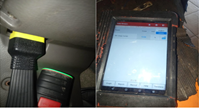Analysis of Air Induction System Testing on the 2011 Daihatsu Xenia Type Xi
##plugins.themes.academic_pro.article.main##
Abstract
Analysis of this air induction system testing aims to analyze the air induction system on Daihatsu Xenia types XI in 2011. The research uses descriptive methods by testing and analyzing Daihatsu Xenia Type XI Mobils in 2011 using the EFI X 431 Pro and multitester scanner to obtain research data. The test results show that: 1. The sensor map is in good condition because the voltage produced ? 3.5 V - 4 V is: 3.7 V. 2. The sensor is in poor condition because the resistance produced is ? 2.21 k ohm - 2,69 K Ohm, namely: 1.74 KOHM. 3. ISC in poor condition because the resistance produced ? 45.6 ohms - 50.4 ohms is: 43.2 ohms. Testing using Scantool Obtained Results: 1. Map sensor has decreased at rpm 2000 of 2 kPa and has increased in rpm 3000 of 2 kPa. 2. IAT Sensors at 1000, 2000 and 3000 RPMs are stable at 480C. 3. ISC at rpm 1000, 2000, and 3000 stable at 6.99 %.
##plugins.themes.academic_pro.article.details##

This work is licensed under a Creative Commons Attribution-NonCommercial 4.0 International License.
References
[2] A. Muzayyin, D. A. Priyono, Hasanudin, and B. Wilantara, “Studi Analisis Sistem Induksi Udara Mobil Toyota Avanza K3-VE Dengan Scanner Launch Thinkdiag Easydiag 4.0,” JASATEC J. Students Automotive, Electron. Comput., vol. 1, no. 1, pp. 10–22, 2021, doi: 10.37339/jasatec.v1i1.610.
[3] A. Rasyidin, Y. Effendi, R. M. Ali, and D. Bagusworo, “Kajian Perbandingan Injector 6 Holes Dengan Injector 8 Holes Terhadap Performa Gasoline Engine Fuel Injection 110 Cc,” SinaMu Simp. Nas. Multidisiplin, vol. 3, no. 1, 2021.
[4] I. Yuswanda, W. T. Putra, and K. Winangun, “Analisa Kevakuman Dan Perbedaan Map Sensor Pada Perubahan Rpm Terhadap Konsumsi Bahan Bakar Dan Emisi Gas Buang Pada Mobil Toyota Kijang Efi 2000,” Komputek, vol. 3, no. 1, pp. 33–45, 2019, doi: 10.24269/jkt.v3i1.251.
[5] T. Sugiarto, “Analisa Kerja Manifold Absolute Pressure (Map) Dan Kadar Kandungan Emisi Gas Buang Yang Dihasilkan Pada Motor Bensin Dengan Sistem Injeksi Elektronik Type D-Efi,” Elektron J. Ilm., vol. 5, no. 2, pp. 69–74, 2013, doi: 10.30630/eji.5.2.56.
[6] I. W. Handoko and N. A. Hasibuan, “Sistem Pakar Deteksi Kerusakan Map Sensor Pada Mobil Honda,” Konf. Nas. Teknol. Inf. dan Komput., vol. I, no. 1, pp. 167–170, 2017.
[7] W. Purwanto, A. Bahrudin, T. Sugiarto, D. S. Putra, and N. Hidayat, “The Design And Development Of Voltage Amplifiers Using Microcontroller For Mass Absolute Pressure (Map) Sensor In The Toyota Avanza,” VANOS J. Mech. Eng. Educ., vol. 3, no. 2, pp. 93–100, 2018.
[8] B. S. Nugraha, “Aplikasi Teknologi Injeksi Bahan Bakar Elektronik (EFI) untuk mengurangi Emisi Gas Buang Sepeda Motor,” Ilm. Pop. dan Teknol. Ter., vol. 5, no. 2, pp. 661–740, 2007.
[9] H. Sari and A. Wailanduw, “Rancang Bangun Alat Monotoring Kerja Sensor Pada Sepeda Motor Injeksi,” vol. 07, no. 1, pp. 40–46, 2022.
[10] S. Rizal, Sistem Induksi Udara (Air Induction System) Dan Troubleshooting Pada Mesin Toyota Vios 1nz-Fe. 2013.
[11] W. Prasetyo, N. A. Ariyanto, and Syarifudin, Trouble Shooting Menggunakan Scanner Launch X431.
[12] A. W. Pramayudha, G. Gunarko, A. Darmanto, and F. A. Widiharsa, “Kaji teoritis EMS (Engine Management System) dengan variasi temperatur air pendingin dan beban kerja pada kondisi stasioner pada kendaraan Toyota Avanza,” Turbo J. Progr. Stud. Tek. Mesin, vol. 9, no. 2, pp. 279–288, 2020, doi: 10.24127/trb.v9i2.1180.
[13] C. D. Mulyadi, “Pengaruh Penyetelan Tegangan Throttle Position Sensor ( Tps ) Dan Idle Speed Control ( Isc ) Terhadap Daya Mesin Serta Emisi Gas Buang Pada Sepeda Motor 108 Cc,” J. Ilm. TEKNOBIZ, vol. 3, no. 3, pp. 105–109, 2013.

